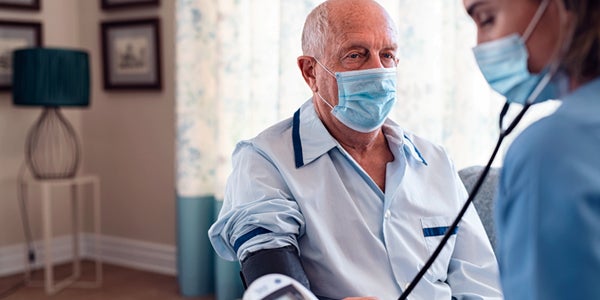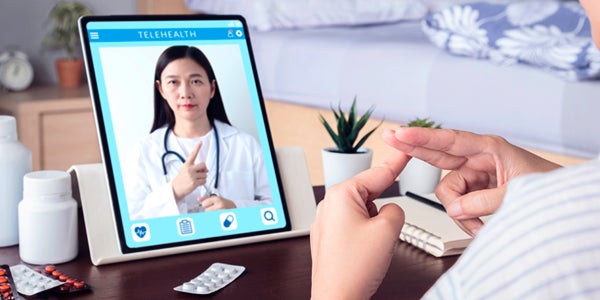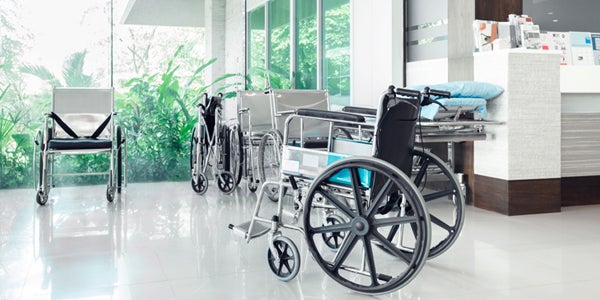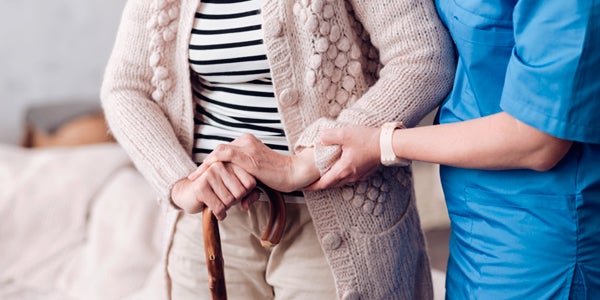Now more than ever, skilled nursing facilities face overwhelming operational challenges. It’s past time to consider AI and the latest digital trends into skilled nursing facilities to ease nurses’ burdens and provide better, safer care.
The Covid-19 pandemic shook the senior care industry to its core, amplifying long-standing issues into new catastrophes. Burnout and high turnover rates remain among the most disruptive roadblocks for long-term skilled nursing facilities. According to research published in the New York Times, turnover and burnout rates among nursing staff soured to a national average of 128% in the throes of the pandemic, reaching as high as 300% in some facilities.
Assisted living and nursing home operators did their best to compensate for the hardships brought on by the pandemic. Operators introduced new safety protocols to ensure the safety of patients and staff alike. Still, the rapid development of Covid-19 in facilities correlated with staff shortages and overburdened workers. Because skilled nursing requires hands-on care, it became easier to spread the disease to vulnerable patients.

Time to Sit Up and Make Changes
In the wake of the crisis, skilled nursing facilities must look at what steps they can take to alleviate the outsize burdens on staff. Technology, automation, and AI aren’t just reserved for the commercial sector. Implementing AI and other digital trends into long-term skilled nursing facilities can help ease nurses’ burdens, allowing them to provide better, safer care.
Senior care has missed groundbreaking opportunities to improve the quality of care in facilities and the quality of life for their dedicated nursing staff. As emerging tech proves itself in other sectors, how can long-term skilled nursing facilities leverage it in their day-to-day operations?

1. Better Accuracy in Medication Management
Medication management strategies may differ depending on how and where patients receive treatment, adding to the challenges many patients face at skilled nursing facilities.
For example, consider older patients and those with disabilities, who are at heightened risk for chronic disease. These patients also tend to have multiple health care providers and care transactions, while simultaneously often dealing with diminished cognition. Managing medications can become exceedingly difficult for these patients. Compounded with problems of medical mismanagement on the facility side, this can prove a recipe for tragedy. As a result, patients in long-term skilled nursing facilities could be more at risk for adverse drug events (ADEs) related to medication mismanagement.
The Benefit of Medication Management Technologies
Polypharmacy, or the prescription of multiple medications to treat numerous diseases, only puts these patients at more risk. After all, the more medication one takes, the more susceptible they are to ADEs and medication mismanagement. Not to mention that these providers and pharmacies often prescribe medications without a clear history of the patient's health record and current prescriptions! The risks get even higher when patients with cognitive impairment forget to take medications, or accidentally take more than what's prescribed.
Typically, these sorts of errors at facilities originate in the prescription, dispensation, and administration phases. As such, while these incidents may be common, that means they are also somewhat preventable. Thankfully, skilled nursing facilities now have several medication management technologies available to prevent ADEs, including:
- Electronic Health Records (EHRs): Fully integrated EHRs enable data-sharing between the discharging hospital or healthcare provider (which was found in need of significant improvement by a JAMA study) and paints a complete record of patient health as they move between providers and facilities. Nurses can see a complete list of medications, allergies, existing problems, and past ADE events.
- Computerized Physician Order Entries (CPOEs): These computer-based systems automate medication ordering processes and transmit them to labs, nursing homes, and pharmacies.
- ePrescriptions: ePrescriptions are typically the core operating system of CPOEs for writing and prescribing medication. They ensure clear communication between providers, pharmacies, and patients, eliminating hand-written and possibly illegible prescriptions that can lead to errors.
- Clinical Decision Support Systems (CDSSs): CDSSs come with interactive software to help providers in skilled nursing facilities with decision-making tasks, such as determining diagnoses and issuing warnings.

Manage Medications with Heightened Accuracy
Aside from these upstream technologies, there are also several downstream technologies skilled nursing facilities can leverage to manage medications with heightened accuracy:
- Telepharmacy: With Covid-19 still proving a significant threat to skilled nursing care, telepharmacy allows nurses to communicate information to patients remotely. They can also more easily communicate with pharmacies concerning patient care.
- Electronic Medication Administration Records (eMAR): Nurses can leverage eMAR to bolster workflows by documenting administration times for medication ordered electronically. eMAR systems record the medication, dosage, and time taken while providing special administration instructions.
By implementing these digital technologies, long-term skilled nursing facilities can improve upon their prescribing and ordering practices by catching and reducing errors. These implementations help catch provider-patient miscommunications and lead to more timely reports, in turn leading to more frequent Medicare reimbursements. At the same time, these systems also increase worker efficiency by automating quick and detailed medical information.

2. AI Helps Prevent Falls and Other Injuries
Every year, millions of elderly people end up in the ER from fall-related injuries. Globally, healthcare experts are looking for new ways to ensure the safety of older generations, determined to figure out why they fall at such alarming rates. Skilled nursing facilities can implement AI technology to help mitigate these instances.
In 2019, staff at El Camino Hospital in California utilized predictive analysis to reduce fall rates by 39% in just six months. Working with a dedicated analytics team, the hospital examined high-risk patients' electronic health record data. Two universities in North Carolina used cameras and virtual reality systems to record and analyze 30 different body markers worn by elderly patients. Researchers had them walk on a treadmill, and used visual cues to identify undiagnosed balance impairments.
Walking requires balance and coordination of the muscles to propel the body forward. Abnormalities in a patient's gait play a significant role in their fall frequency.
At some skilled nursing facilities working to combat these falls, residents have "gait night," when they participate in exercises to analyze their walking patterns. Residents walk back and forth in front of a camera that identifies deterioration in their gait. The activity "only takes 20 seconds," according to Nick Hughes, CEO, and co-founder of Salus Physical Therapy. "With this technology, we're able to capture more of the seniors in an AI faster than any before," he adds. It helps that residents are eager to participate in the exercise, where some might assume their hesitation towards embracing AI.
At Tiger Place, a Missouri retirement community, staff placed Microsoft Kinect sensors around the facility to log residents' gait, speed, and stride length as they move around the building. If the sensors detect decreases in those variables, it alerts the staff, who can respond to the patient's location before they fall.
Long-term skilled nursing facilities worldwide are also embracing AI and other technological trends to combat staff shortages and improve the quality of care. At Shenzhen Nursing Home in China, staff worked side-by-side with Tencent, a Chinese multinational tech and entertainment conglomerate. Shenzhen utilizes a system of "invisible caregivers," deploying over 100 cameras/detectors to sense when someone falls.
Before, these cameras were only outside, for privacy reasons. However, sensors added inside the facility now use thermal imaging and sounding alarms to detect patient falls as they occur. In addition, patients in Shenzhen have tablets connected to their bedsides that track their physical condition while they watch TV, play games, and order food. The eye-tracking technology also allows patients to express their needs if they cannot speak or move.

3. Increase Care Efficiency With Real-Time Location Systems
Healthcare providers can increase the effectiveness and standard of treatment by utilizing a number of innovative and omnipresent technologies. For example, skilled nursing facilities can embrace real-time location systems (RTLS) to track patients and assets in real-time.
Think of RTLS as GPS technology, on a patient scale. These small mobile tags track assets and people as they move around the facility, providing real-time data for staff members. In recent years, several industries have turned to RTLS, including eCommerce and construction. It’s time for nursing homes consider how RTLS can help busy staff and improve patient outcomes.
By leveraging RTLS, skilled nursing facilities can mold a sophisticated framework for senior care. One nurse cannot stay with a patient 24/7. RTLS allows staff to keep track of all patients throughout the facility, turning their attention to those at heightened risk of falling when they are, for example, walking unsteadily around the facility or nearing a flight of stairs.
Aside from patients, RTLS also helps nursing staff members keep track of assets around the facility. A significant portion of non-care time gets consumed as staff documents, searches for, and transports necessary equipment. Wheelchairs, walkers, pumps, monitors, and various forms of mobile equipment are shared facility-wide. RTLS informs staff members of where everything is at all times, drastically decreasing the time they spend searching. RTLS also addresses areas of concern like human error, hoarding, loss, misuse, and, unfortunately, theft.
When equipment goes missing or breaks from misuse, facilities must spend money on replacements. Furthermore, misplaced or broken equipment diverts crucial time away from care as staff scrambles to find what they need.

The Benefits of RTLS Technology in Skilled Nursing Facilities
Implementing RTLS technology lets facilities distribute and keep track of their equipment more efficiently. Overall, staff equipment use can increase upwards of 20% with RTLS use: since they move faster, they can direct more time to patient care. As a result, productivity and efficiency increase while capital expenses diminish.
Skilled nursing facilities can also utilize RTLS to bolster the quality of care, not just the quantity. For example, wireless emergency call buttons fitted with RTLS technology provide nurses with a patient's exact location within the facility. Patients can wear call buttons as bracelets, badges, or pendants, alerting the staff as soon as they have a need.
RTLS helps in wander management, alerting nurses when a patient is nearing a hazardous situation. Wandering is physically hazardous for the patient and a significant financial risk for the facility. The Alzheimer's Association predicts that 60% of Alzheimer's patients will wander, which can lead to severe injury and, unfortunately, death. Also known as elopement, injury resulting from wandering can lead to steep lawsuits filed against facilities. RTLS alerts nurses when a patient nears a hazardous area or hasn't been active for a window of time. Now, they can intervene before accidents happen.
Invest in Modernizing Your Skilled Nursing Facilities Today
Now more than ever, long-term skilled nursing facilities face overwhelming operational challenges, as nursing shortages continue to affect the industry. In these times, reaching out to a trusted financial partner like Citywide Banks, a division of HTLF Bank with deep industry expertise is key to helping you decide which investments can have the biggest impact.







